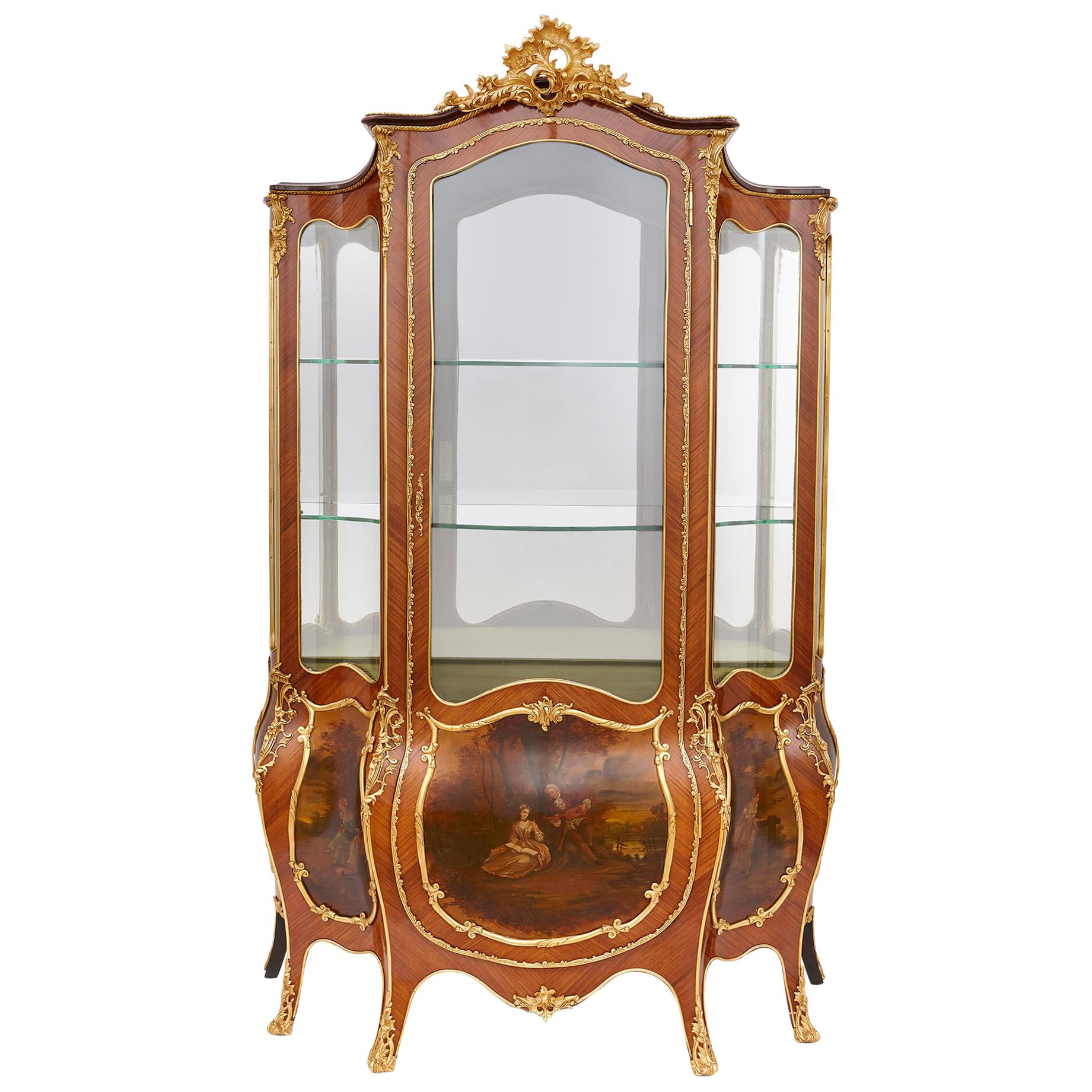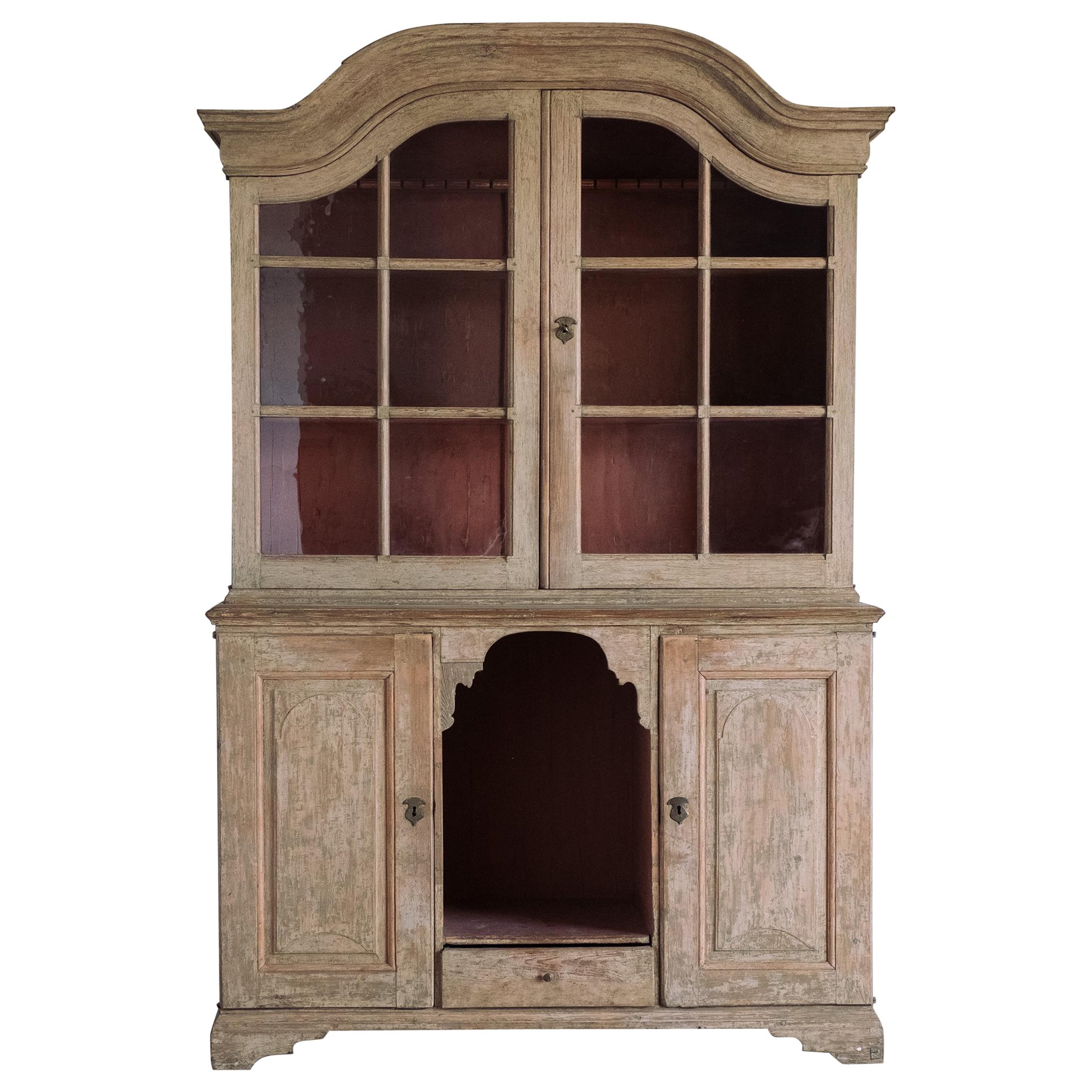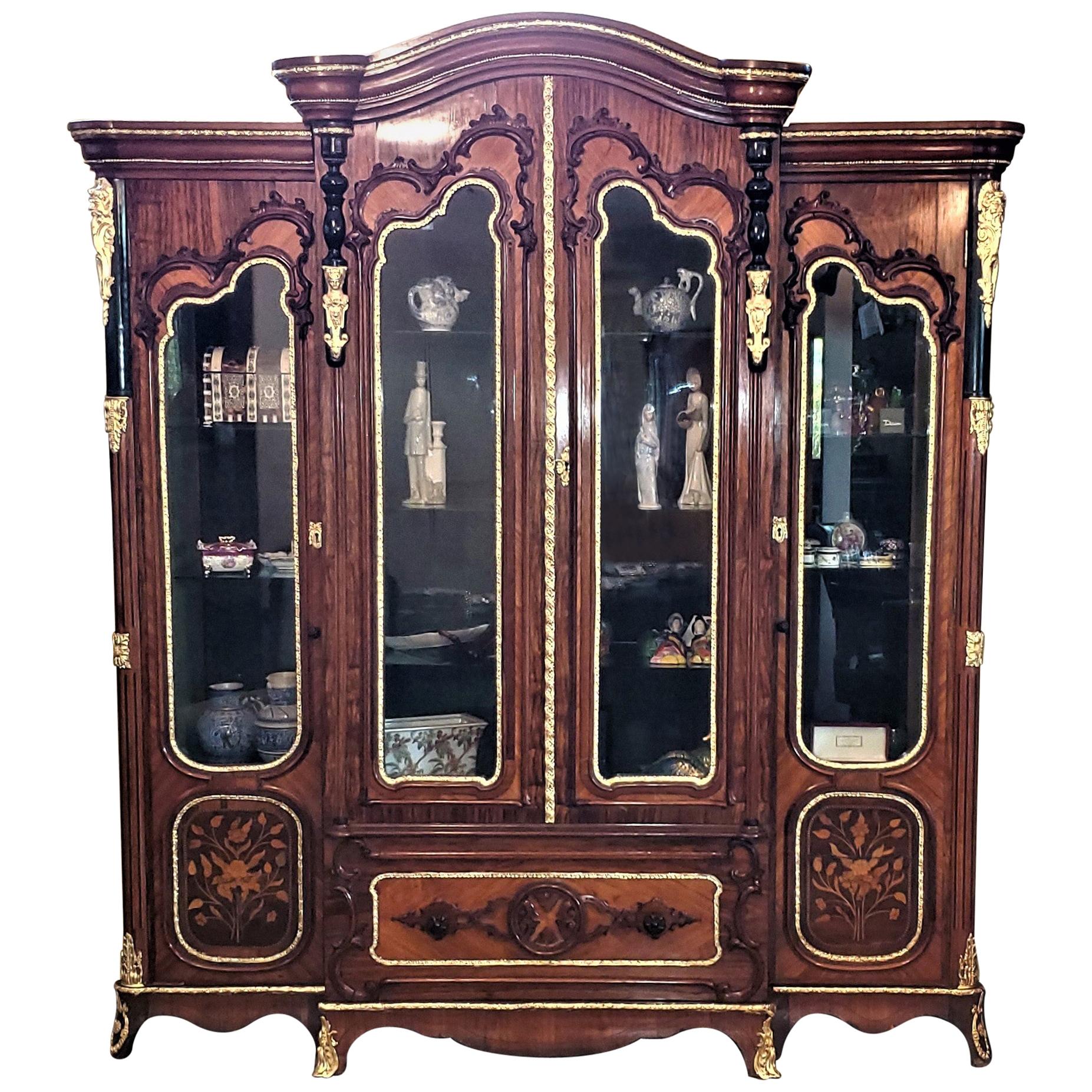Items Similar to Italian Rococo-Style Giltwood Vitrines
Want more images or videos?
Request additional images or videos from the seller
1 of 5
Italian Rococo-Style Giltwood Vitrines
About the Item
This extraordinary pair of Rococo-style vitrines is an exceptional example of Italian cabinetry. Beautifully designed and executed in giltwood, the stunning pair is set apart by a profusion of classic architectural details. The elegant lines, foliate decoration and detailed accents are all a study in Rococo glamour. Each opulent vitrine is set atop a beautifully carved walnut stand, adding further grandeur to the magnificent pair.
Italian, 19th century
Measures: 69" high x 23" wide x 9" deep.
- Dimensions:Height: 69 in (175.26 cm)Width: 23 in (58.42 cm)Depth: 9 in (22.86 cm)
- Style:Rococo (In the Style Of)
- Materials and Techniques:
- Place of Origin:
- Period:
- Date of Manufacture:19th Century
- Condition:
- Seller Location:New Orleans, LA
- Reference Number:
About the Seller
5.0
Recognized Seller
These prestigious sellers are industry leaders and represent the highest echelon for item quality and design.
Established in 1912
1stDibs seller since 2010
93 sales on 1stDibs
Typical response time: 6 hours
- ShippingRetrieving quote...Ships From: New Orleans, LA
- Return PolicyThis item cannot be returned.
More From This SellerView All
- 19th Century French Vitrine by Francois LinkeBy François LinkeLocated in New Orleans, LAThis rare and stunning vitrine was crafted by the illustrious French ébéniste François Linke. A master of the Louis XVI style, Linke was renowned for his highly original designs t...Category
Antique 19th Century French Rococo Vitrines
MaterialsBronze
- 19th Century Coromandel Inlaid VitrineLocated in New Orleans, LAHighly-prized coromandel, or East Indian ebony, was used to create this beautiful Victorian vitrine. Featuring delicate inlay in the Victorian/Edwardian style and glass panels framed in the equally luxurious satinwood, this cabinet is constructed to fit flush against a wall with baseboards. Elegant cabinets such as this are perfect for displaying one's treasures, but with original locks, keys, mirrors and fleur-de-lis fabric, this case is a prized possession unto itself, circa 1890. Measures: 30" wide x 14 ½" deep x 41 ½" high. Coromandel ebony is variegated brown and black, often called "streaky," wood. It is considered a highly valuable wood for turnery, fine cabinet...Category
Antique 19th Century English Victorian Vitrines
MaterialsGlass, Mirror, Ebony, Satinwood
- Sheraton Revival Hand-Painted VitrineLocated in New Orleans, LAThis exceptional English vitrine features the stylistic elements associated with the famed English furniture designer Thomas Sheraton, considered one of the three most influential En...Category
Antique 19th Century English Sheraton Vitrines
MaterialsSatinwood
- Italian Baroque Iron SafeLocated in New Orleans, LAVisually imposing and mechanically complex, this formidable Italian Baroque safe would have provided unparalleled security for storing valuables in the 18th century. The hobnail motifs covering the safe are a testament to the fine artistry and craftsmanship of Piedmont metalworkers of this time. Beautifully restored and fully functional, this iron safe...Category
Antique 18th Century Italian Baroque Cabinets
MaterialsIron
- 18th Century Italian Iron Floor SafeLocated in New Orleans, LAThis rare and imposing 18th-century safe hails from the Turin region of northwestern Italy, and is crafted of reinforced wrought iron designed to be virtually indestructible. Impenet...Category
Antique 18th Century Italian Cabinets
MaterialsIron, Wrought Iron
- 19th-Century Italian Giltwood MirrorLocated in New Orleans, LAThe exquisite details of this hand-carved Italian giltwood mirror are matched in grandeur by its notable size. Nearly 3 feet tall by 3 feet wide, this mirror is an extraordinary feas...Category
Antique 19th Century Italian Rococo Wall Mirrors
MaterialsMirror, Giltwood
You May Also Like
- Rococo Style Gilt Bronze and Vernis Martin Vitrine CabinetLocated in London, GBThis large and exquisite vitrine cabinet is a true statement piece and would make the perfect place to display an antique collection of curios or fine tableware. The cabinet is c...Category
Antique 19th Century French Rococo Vitrines
MaterialsOrmolu
- 18th Century Rococo Vitrine CabinetLocated in Mjöhult, SEFine and unusually wide 18th-century original Rococo vitrine cabinet, circa 1770, Sweden. Top vitrine containing two shelves and one spoon shelf. The bottom part with two doors with two shelves each. One open compartment originally used for keeping the water canister.Category
Antique 18th Century Swedish Rococo Cabinets
MaterialsWood
- Swedish Rococo Style 19th Century Painted Wood Vitrine Cabinet with Glass DoorsLocated in Atlanta, GAA Swedish Rococo style painted wood vitrine cabinet from the 19th century, with bonnet top, glass doors and bombé chest. Created in Sweden during the 19th century, this Rococo style cabinet...Category
Antique 19th Century Swedish Rococo Cabinets
MaterialsGlass, Wood
- Swedish Rococo Style 19th Century Painted Vitrine with Glass Doors and DrawersLocated in Atlanta, GAA Swedish Rococo style painted wood vitrine from the 19th century, with bonnet top and glass doors. Born in Sweden during the 19th century, this exquisite vitrine features a bonnet-t...Category
Antique 19th Century Swedish Rococo Vitrines
MaterialsGlass, Wood
- Large 19 Century French Rococo or Neoclassical Revival Style VitrineBy David RoentgenLocated in Dallas, TXStunning 19th century French Empire, neoclassical/Rococo Revival style Marquetry vitrine or display cabinet, of large proportions!! A real statement piece! Made of a fabulous variety of veneers, including kingwood, satinwood, tulipwood, harewood and walnut with quality classical ormolu mounts. It has ebonized pillars in the Empire style, with walnut and exotic hardwood friezes in the Rococo style. Double glass doors to middle section and single glass doors on either side. The glass on the doors are framed in ormolu banding. Floral Marquetry panels on front and parquetry on the sides. The front central section is a pullout / pull-out drawers with gorgeous walnut frieze panel and original carved walnut knobs. Scrolling pelmet on the top in 3 sections banded in ormolu beading. Scrolling base with cabriolet feet and ormolu mounts on base. Various ormolu mounts, floral mounts, mounts of Baachus and mounts of neoclassical female figures. In 3 sections. with 2 side cabinets and large central section with 3 section pelmet, stunning piece!!! The quality ormolu mounts are marked with the letter “R” and what appears to be “FR 678”. We were originally of the belief that this piece might have been made at the very end of the 19th century, but having regard to the quality of workmanship throughout this piece we are of the opinion that it was most likely made in the third quarter of the 19th century, circa 1870 and by an obviously top quality Parisienne maker with a surname beginning with “R”. It is definitely in the style of David Roentgen who was known for his Rococo/neoclassical styles. David Roentgen, (born Aug. 11, 1743-died Feb. 12, 1807, Wiesbaden, Duchy of Nassau), cabinetmaker to Queen Marie-Antoinette of France; under his direction the family workshop at Neuwied (near Cologne), founded by his father, Abraham Roentgen, became perhaps the most-successful firm of furniture production in the 18th century. After succeeding his father as head of the Neuwied workshop in 1772, Roentgen strove to broaden their clientele, an ambition that brought him first to Hamburg and ultimately to Paris (1774), where in 1779 he was spectacularly successful in selling his finest furniture to King Louis XVI of France for £3,300 to £4,000, an unprecedented sum for the time. Appointed cabinetmaker to the queen, Roentgen was granted admission (1780) as maître-ébéniste (master cabinetmaker) to the trade corporation of Paris cabinetmakers, making it possible for him to keep in Paris a stock of the furniture manufactured at Neuwied. Thus he was able to compete with such great cabinetmakers as Jean-Henri Riesener and Adam Weisweiler, reputedly his former pupil at Neuwied. After his first visit to St. Petersburg, Empress Catherine II the Great bought huge quantities of his furniture; King Frederick William II of Prussia was also his client. When in 1795 the French Revolutionary armies threatened to cross the Rhine, Roentgen evacuated his establishment and moved his stock farther inland. Unfortunately, he lost everything in his Parisian salon and in his Neuwied workshop, both of which were sacked by Republican troops. He was crushed, despite his appointment as court furnisher to the king of Prussia. Although he never succeeded in starting production again, former apprentices of his whom he helped to establish in the German cities of Berlin (David Hacker...Category
Antique Mid-19th Century French Rococo Revival Vitrines
MaterialsOrmolu
- European 1790s Rococo Tall Vitrine Secrétaire with Carved Scrolled PedimentLocated in Atlanta, GAA European Rococo period painted wood two part vitrine secretary from the late 18th century, with carved volutes, glass doors and slanted-front desk. Created in Europe during the las...Category
Antique Late 18th Century European Rococo Cabinets
MaterialsWood
Recently Viewed
View AllMore Ways To Browse
Rococo Antique
Rococo Antique Furniture Rococo Antique Furniture
Rococo Antique Furniture
Antique Rococo Furniture
Antique Italian Furniture Styles
Rococo Style
Giltwood Italian
Rococo Dining Style Furniture
Antique Italian Rococo
Italian Rococo Style
Italian Rococo Dining
Rococo Architecture
Rococo Style Case Pieces And Storage
Antique Giltwood Stand
Italian Vitrine
Used Cabinetry
Antique Walnut Vitrine
Rococo Style Walnut Furniture





